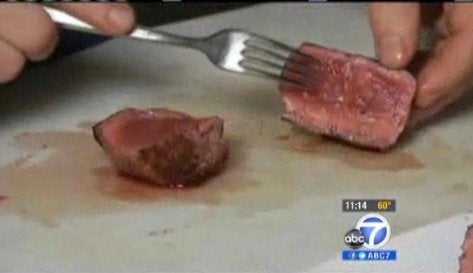
On Monday, KGO-TV, the San Francisco affiliate of ABC, aired a report on transglutaminase, more commonly known as "meat glue." The clip, embedded below, features chef Staffan Terje of Perbacco Restaurant in San Francisco demonstrating how the powder works. It's basically what it sounds like -- meat glue allows proteins to fuse together to form one connected piece of meat. It's a process that has been known about for some time, but this ABC piece focuses on the consumer health risks. The report explains:
The outside of a piece of meat comes in contact with a lot of bacteria making its way from slaughterhouse to table. Usually cooking a steak on the outside will kill all that off. The center of a single cut of steak is sterile, that's why you can eat it rare. But glued pieces of meat could contain bacteria like E. coli on the inside.
Transglutaminase is USDA-approved. According to ABC, meat containing transglutaminase is found throughout places that serve meat in bulk, such as banquet dining or high-volume restaurants.
Various blogs have picked up the report, with Gizmodo raising similarities between meat glue and pink slime. While transparency is certainly a concern -- if a person is eating a piece of meat that is actually made up of several smaller pieces of meat, he has a right to know that -- the ABC report reinforces certain myths about meat glue that several chefs have been trying to dispel for years.
Last year, when a different report on meat glue was aired, chef and culinary science expert Dave Arnold offered a well-researched defense of meat glue. He agrees that any restaurant that uses meat glue to cheat its customers should be shut down, but he has "never seen or heard of such a case." (The ABC report doesn't offer specific examples).
Arnold does acknowledge the risk of bacteria contamination, though. He advises several safety precautions, and believes that chefs need to be trained in how to use meat glue.
What the ABC report does not address is the use of meat glue in a way to elevate a certain dish. Chef Wylie Dufresne of New York's wd-50 told the food magazine Meatpaper that "Meat glue makes us better chefs." He's experimented with meat glue in his restaurant by fusing bacon to cod medallions and famed British chef Heston Blumenthal has used it in an innovative mackerel dish. Dufresne told Meatpaper, “People have been manipulating food ever since they realized cooking a whole animal was difficult. Cows don’t come in hot dog form.” Arnold, likewise, believes that meat glue helps chefs cook meat more evenly and consistently. "I'm trying to make it better for the diner," he writes.
Where the disconnect seems to occur between various media reports focusing on the dangers of meat glue and chefs that openly use and praise meat glue is when meat glue is used to mask the identity of the product. Arnold, Dufresne and other prominent chefs have never advocated the use of meat glue to deceive customers, or to use it on cheaper cuts of meat to make a product look better. Rather, these chefs use transglutaminase to stretch culinary boundaries.
So is the use of meat glue scandalous? If a company is cutting corners and using cheaper cuts to make the product look like something else, then yes. But it remains to be seen just how widespread this practice is. (The USDA mandates that transglutaminase must appear on ingredient labels in addition to terms like "formed" or "reformed meat.") But, if a chef is trained on how to use the substance, and uses it in a purposeful way, there isn't a need for meat glue to become the next pink slime.
Read more on meat glue:
Dave Arnold, The Trials of Transglutaminase—The Misunderstood Magic of Meat-Glue
Eater, Watch Wylie Stick Things Together With Meat Glue At Harvard
Meatpaper, A Fish Without Bones
Watch the ABC report:
